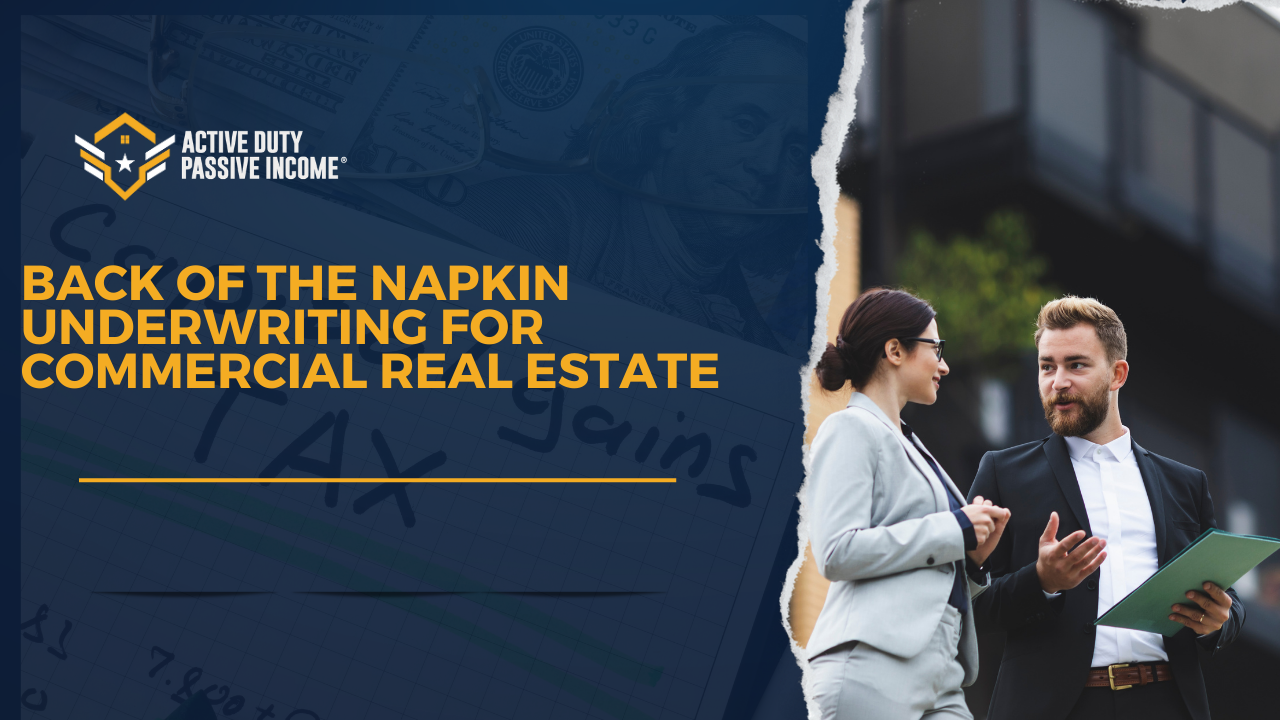Discover the power of quick, effective property analysis with Back of the Napkin Underwriting – your first step towards smarter real estate investments.
In the fast-paced arena of commercial real estate, the ability to make prompt, well-informed decisions sets successful investors apart. Mastering the art of quickly evaluating a property to determine its worth for a deeper dive is a fundamental skill. This is where “Back of the Napkin Underwriting” shines as an indispensable tool for every real estate investor.
What is Back of the Napkin Underwriting?
Back of the Napkin Underwriting is a streamlined approach to assessing the financial viability of a commercial real estate property. It’s akin to doing a rough sketch of a property’s financial portrait using basic numbers. This method is not about precision but about speed and efficiency. It helps investors to quickly sort through options and zero in on properties that merit a more thorough evaluation. In essence, it answers the preliminary question: “Is this property potentially profitable?”
The Importance of Quick Analysis
The real estate market is dynamic, with properties coming onto and leaving the market rapidly. Being able to swiftly analyze a property’s potential can mean the difference between seizing an opportunity and missing out. This rapid assessment skill is invaluable in an investor’s toolkit, helping to focus time and resources on the most promising leads.
What Back of the Napkin Underwriting Is Not
It’s essential to understand that this method is not about detailed financial analysis. Complex calculations regarding investor returns, capital expenditures, cash flow projections, or exit strategies are not part of this initial assessment. The purpose here is to get a quick, albeit rough, financial picture based on initial data which may be unverified or incomplete.
The Process of Back of the Napkin Underwriting
Let’s delve deeper into the steps involved in this quick analysis process.
1. Gathering Basic Information
The foundation of this method lies in collecting essential data about the property. This includes not only the asking price but also any available data on rental income, operating costs, and the property’s location. The accuracy of this information is not as critical at this stage as it is in later, more detailed analyses.
2. Calculating Gross Income
Understanding the total income potential of the property is crucial. This step involves summing up all the income streams from the property, including rent and any ancillary income like parking fees or laundry services.
3. Estimating Operating Expenses
An estimate of the operating expenses gives insight into the ongoing costs of maintaining the property. These expenses encompass a wide range of costs, from property management fees to routine maintenance, and they are subtracted from the gross income to get a clearer picture of the property’s profitability.
4. Understanding Net Operating Income (NOI)
NOI is a pivotal figure in real estate analysis. It represents the income a property generates after all operating expenses but before mortgage payments. A higher NOI often suggests a more lucrative investment opportunity.
5. Considering the Cap Rate
The Cap Rate is a critical metric that helps investors gauge the return on investment. It’s especially useful for comparing different properties. However, it’s important to remember that a higher Cap Rate can also indicate higher risk.
6. Applying the Rule of Thumb
Rules of thumb like the “1% Rule” provide a quick, general gauge of a property’s income potential. They are not definitive but can be helpful in making a quick comparison between multiple properties.
7. Quick Comparison with Market Trends
Finally, aligning your quick analysis with broader market trends is essential. Understanding how the property stands in the context of the local real estate market can provide valuable insights into its potential success.
Limitations and Risks
This method, while efficient, is not foolproof. It’s based on preliminary data that can be inaccurate or incomplete. Hence, it should be viewed as a first step in the investment process, not the sole basis for a decision.
Moving Beyond the Napkin
If a property looks promising after this initial analysis, it’s time for a more in-depth look. This next phase involves thorough due diligence, including verifying financials, assessing the property’s condition, and understanding the local market dynamics. It’s also the stage where seeking professional advice becomes crucial.
Back of the Napkin Underwriting is a powerful tool for quickly identifying potential real estate investments. However, it’s just the starting point. A successful investment requires a deeper dive into the details, ensuring a decision is made with the fullest possible understanding of the property and its potential.
Ready to take your real estate investments to the next level? Start with Back of the Napkin Underwriting to quickly identify promising opportunities, then dive deeper to uncover the true potential of each property. Your journey to smarter, more efficient real estate investing begins here. You can book a freedom call to go over your goals and how to reach them, click the banner below!








